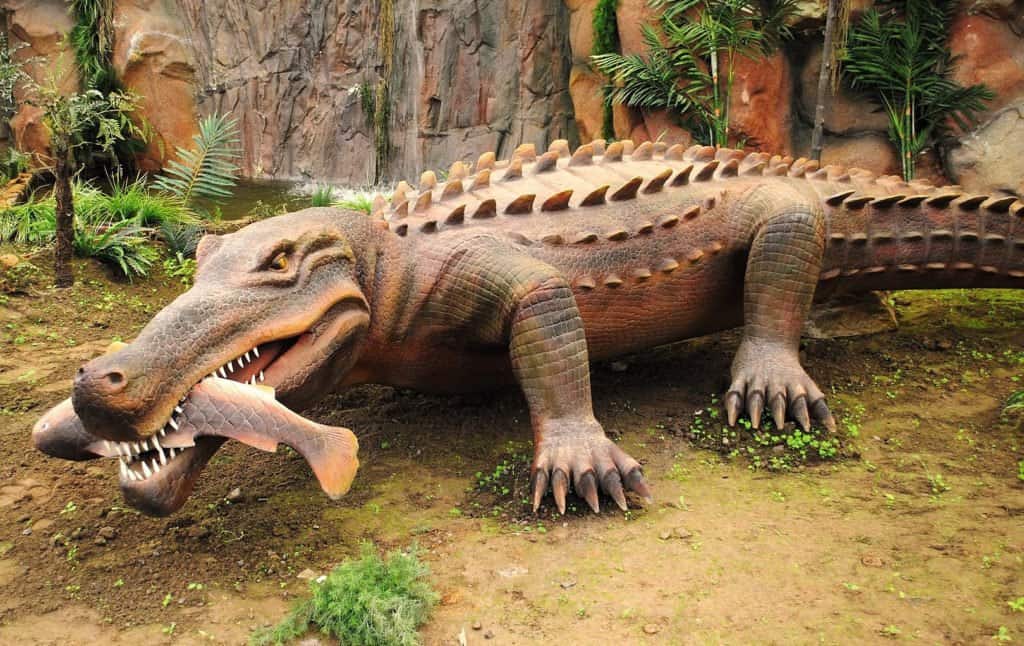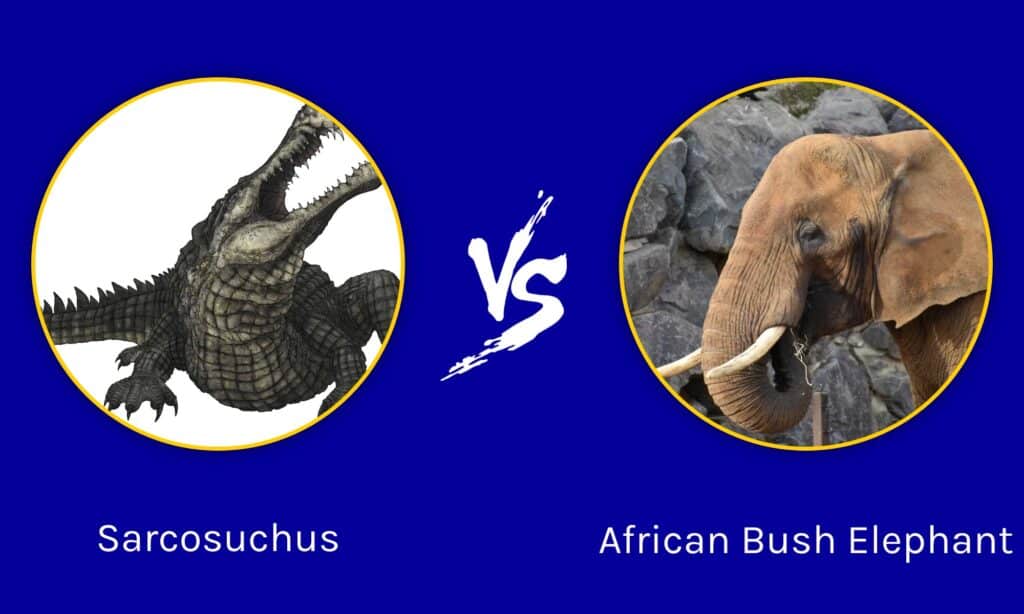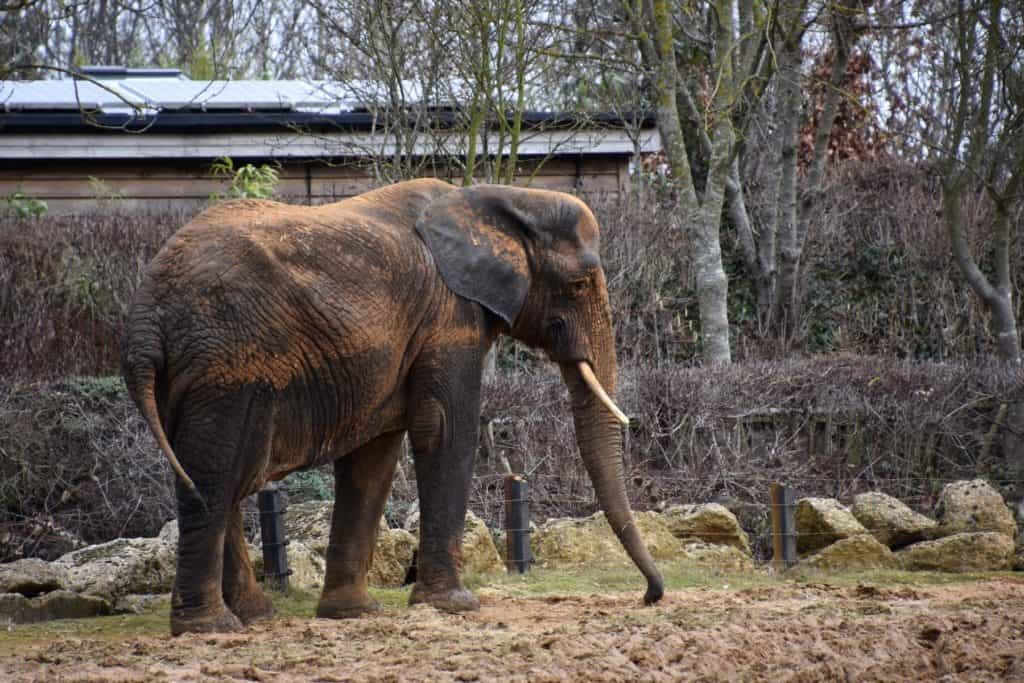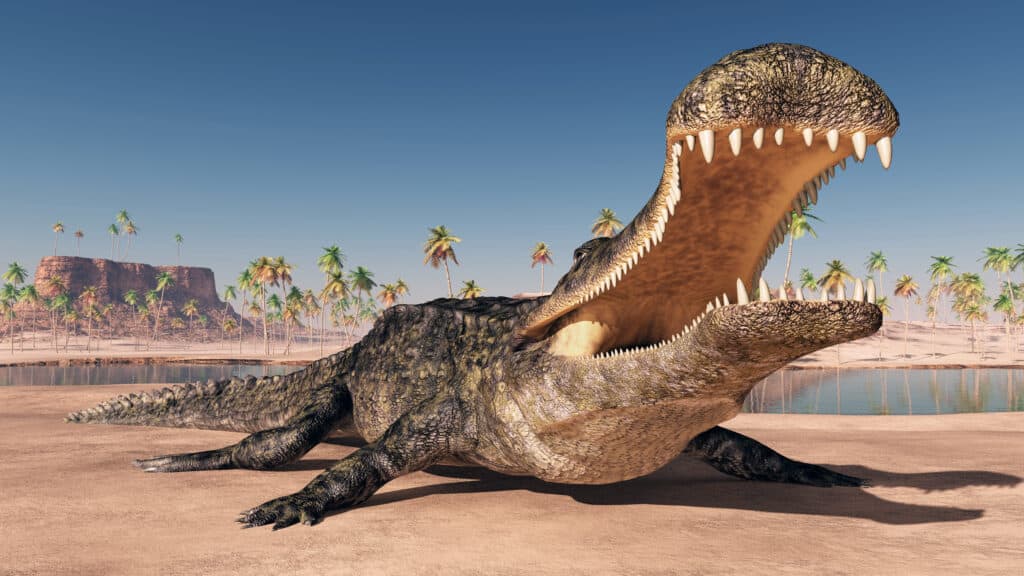African elephants are two of the last three existing elephant species. They are native to Africa and are the largest elephant species, growing bigger than their Asian counterparts.
Of the two types of African elephants, the African bush elephant and the African forest elephant, the former is larger and is found in more than 37 African country forests.
Considering how large these animals are and how ferocious they can get, it’s quite normal to wonder how they would fare in an epic battle against some of history’s largest creatures, such as the largest crocodile ever.
However, unlike many other conceptual battles, it might shock you to discover that such a fight may have actually happened in history. Let’s take an unbiased look at how this epic showdown would have played out.
What Is the Largest Crocodile Ever?

The Sarcosuchus imperator is arguably the largest crocodile species ever.
©HombreDHojalata / CC BY-SA 3.0 – License
The title of the largest crocodile ever belongs to the Sarcosuchus imperator. The Sarcosuchus imperator was a massive crocodile that existed about 95 to 115 million years ago and went extinct about five to 10 million years ago.
Nicknamed the super croc, the Sarcosuchus imperator’s fossil remains were found in a desert in the African country of Niger. Scientists discovered the fossils in a region of the Ténéré Desert.
Niger also happens to be home to the African bush elephants who came into existence about 60 million years ago. And as you probably know, African bush elephants are known to live in deserts, so it isn’t impossible that these animals might have met.
Comparing the Sarcosuchus Imperator and an African Bush Elephant

| Sarcosuchus Imperator | African Bush Elephant | |
|---|---|---|
| Size | Up to 40 feet long and 17,637 pounds Snout-vent length of 18.7 feet | 13 feet tall, 24 feet long, and 15,432 pounds Trunk length of 6 to 7 feet |
| Movement and Speed | Not specified, but large crocodiles can move at speeds of 15 to 22 miles per hour | 25 miles per hour |
| Defenses | Good hearing (300 Hz to 8 kHz) Eyes at the top of their head | Excellent memory Excellent hearing (14 Hz to 12 kHz) |
| Attack | Uses its head and tail like a whip to slash skin. Extremely strong teeth and jaws for biting They grab their victims and roll around with them, dragging them deep into the water in order to drown. | Ivory tusks for impaling Heavy legs for trampling Extremely strong tusks, which they use to grab and slam victims to the ground They crush victims with their heads |
| Predatory Behavior | Ambush predators who practice cannibalism Extremely aggressive natures | Elephants are usually non-confrontational and are herbivores. |
What Are the Key Differences Between the Sarcosuchus Imperator and the African Bush Elephant?

Elephants are not as aggressive as crocodiles.
©Millie Bond – Copyright A-Z Animals
The major difference between the Sarcosuchus imperator and the African elephant is their size. The super croc is almost twice the length of the elephant. However, the African elephant stands at an impressive 13 feet, which is much taller than the Sarcosuchus imperator, although its height isn’t specified.
Another important factor is the level of aggression these animals hold. Crocodiles are known to have a mean streak in addition to their extreme aggression. They are one of the most dangerous animals on Earth. This isn’t to say that elephants aren’t dangerous – they are!
However, they aren’t as confrontational as crocodiles and rarely attack unprovoked. This could be because of their intelligence as well as their natures. Elephants often launch warning attacks to scare humans away, but when a crocodile goes after a human, it goes for blood.
According to a study published by Bill Gates, elephants kill about 100 people a year, while crocodiles kill 1,000, which is ten times more!
What Are the Key Factors in a Fight Between the Sarcosuchus Imperator and an African Bush Elephant?
Considering who would win in this fight can only be done fairly by considering certain parameters. Let’s consider two of them.
Size
Considering the sizes of the Sarcosuchus imperator (40 feet and 17,637 pounds) and the African bush elephant (24 feet and 15,432 pounds), it’s quite easy to see that the super croc has an advantage. Not only is it heavier than the African elephant, but its snout-vent is about 18.7 feet, which is almost as long as the elephant’s entire body.
Elephants usually have an advantage due to their trunk length, which is sometimes as long as seven feet, but that isn’t the case here, considering the Sarcosuchus imperator’s snout size.
Modes of Attack
Despite not being as large as their ancestors, modern-day crocs sometimes dare to go after elephants. They do not launch their attacks lightly and almost always use the element of surprise to their advantage.
The crocodile goes for its victim and pulls it into the water, rolling around with it and dragging it deep into the water until its victim is drowned. They also use their heads and tails like whips to cut through flesh. A whip of the crocodile’s tail is strong enough to break a human’s leg.
However, elephants also have unique attack abilities. Their trunks are strong enough to lift close to 800 pounds and slam it to the ground, and they have amazing muscle strength combined with their tusks, which they use similarly to hands. In addition, their heavy legs can crush many animals, such as modern-day crocodiles, to death.
Both animals have strong attacks, but considering that crocodiles are ambush attackers, they would have an advantage.
Who Would Win in a Fight Between the Sarcosuchus Imperator and an African Bush Elephant?

The Sarcosuchus imperator would beat an African bush elephant in a fight.
©Michael Rosskothen/Shutterstock.com
Although an elephant would easily trample a modern-day crocodile, it would lose in a battle against the Sarcosuchus imperator for a number of reasons. The elephant’s trunk would do very little against the sheer size and aggression of the super croc. The Sarcosuchus imperator would simply bite the elephant’s trunk, and because of its 18.7-foot snout, the elephant’s 8-feet trunk would be minced meat.
Another reason that the Sarcosuchus imperator would win is its weight. Elephants usually ward off crocs who have snatched up their trunks by lifting them in the air and throwing them up and away. They also use their massive tusks to lift animals into the air. However, they wouldn’t be able to lift the Sarcosuchus imperator with either their tusks or trunks.
In addition, elephants are a lot less confrontational and mean than crocodiles, and the Sarcosuchus imperator’s sheer aggression would put these mammals at yet another disadvantage.
Another important factor is location. If the battle took place far away from water, the elephant would probably be able to run away, as it is faster than modern-day crocs- although it is worth noting that the super croc may have moved faster than modern-day crocs. Also, if the elephant got behind the Sarcosuchus imperator in a bid to run away, it would allow the crocodile to use its tail as a whip and slash it.
However, if there is any body of water close by, the croc would clamp its jaws around the elephant and turn or roll around without letting go. It would drag it into the water and drown it quite easily, considering its size.
One last point to consider is that modern-day crocs sometimes kill baby elephants and even sick or injured elephants, despite the size disadvantage, so the Sarcosuchus imperator would most definitely win in a fight against the African bush elephant.
Could Sarcosuchus Imperator Win Against a Megalodon?
Could the prehistoric croc defeat a prehistoric shark? It seems like a fair fight, so let’s explore whether the Sarcosuchus imperator could defeat a mighty megalodon!
We know that the Sarcosuchus imperator was huge at 40 feet in length and weighing 17,637 pounds – but the megalodon was 60 feet long and weighed 60 tons. Its diet consisted of large whales, dolphins, rays, sea cows, sharks, crocodiles, and even other megalodons! It had a bite force of 20 tons and could swim up to 35 mph in short bursts.
It is obvious that the megalodon was much bigger and stronger – but is size everything? The Sarcosuchus imperator was more intelligent, agile, and a faster swimmer.
Unfortunately for the Sarcosuchus imperator, the size would have mattered in this case – especially the size of the megalodon’s crushing bite force. A bite with 20 tons of force behind it could easily crack the croc in half. The crocodile would also be disadvantaged by the inability to use the death roll on such a monstrous creature. The megalodon would almost certainly destroy and devour the largest croc to ever live.
The photo featured at the top of this post is © Homo Cosmicos/Shutterstock.com
Sources
- Seaworld Parks and Entertainment, Available here: https://seaworld.org/animals/all-about/elephants/senses/#:~:text=Hearing,%2C%20in%20long%2Ddistance%20communication
- GatesNotes, Available here: https://www.gatesnotes.com/health/most-lethal-animal-mosquito-week
- The Nature Conservancy, Available here: https://www.nature.org/en-us/get-involved/how-to-help/animals-we-protect/african-bush-elephant/
Thank you for reading! Have some feedback for us? Contact the AZ Animals editorial team.






